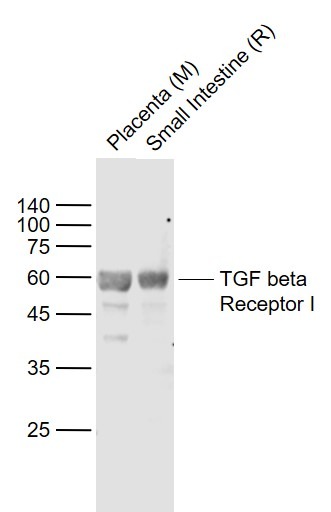Shopping Cart
Remove All Your shopping cart is currently empty
Your shopping cart is currently empty
Anti-TGFBR1 Polyclonal Antibody is a Rabbit antibody targeting TGFBR1. Anti-TGFBR1 Polyclonal Antibody can be used in IF,IHC-Fr,WB.
| Pack Size | Price | USA Warehouse | Global Warehouse | Quantity |
|---|---|---|---|---|
| 50 μL | $222 | 7-10 days | 7-10 days | |
| 100 μL | $374 | 7-10 days | 7-10 days | |
| 200 μL | $528 | 7-10 days | 7-10 days |
| Description | Anti-TGFBR1 Polyclonal Antibody is a Rabbit antibody targeting TGFBR1. Anti-TGFBR1 Polyclonal Antibody can be used in IF,IHC-Fr,WB. |
| Synonyms | tβR-I, TGFβRI, TGF-β RI, TGFR-1, TGF-bRI, TGFBR1, TGFbetaRI, TGF-beta RI, TGFB1R1, tbetaR-I, SKR4, LDS2A, LDS1A, ALK-5, ACVRLK4, AAT5 |
| Ig Type | IgG |
| Reactivity | Human,Mouse,Rat (predicted:Cow) |
| Verified Activity | Sample: Lane 1: Placenta (Mouse) Lysate at 40 μg Lane 2: Small intestine (Rat) Lysate at 40 μg Primary: Anti-TGF beta Receptor I (TMAB-01830) at 1/1000 dilution Secondary: IRDye800CW Goat Anti-Rabbit IgG at 1/20000 dilution Predicted band size: 56 kDa Observed band size: 58 kDa  |
| Application | |
| Recommended Dose | WB: 1:500-2000; IHC-Fr: 1:100-500; IF: 1:100-500 |
| Antibody Type | Polyclonal |
| Host Species | Rabbit |
| Subcellular Localization | Cell membrane; Single-pass type I membrane protein. Cell junction, tight junction. |
| Tissue Specificity | Found in all tissues examined, most abundant in placenta and least abundant in brain and heart. |
| Construction | Polyclonal Antibody |
| Purification | Protein A purified |
| Appearance | Liquid |
| Formulation | 0.01M TBS (pH7.4) with 1% BSA, 0.02% Proclin300 and 50% Glycerol. |
| Concentration | 1 mg/mL |
| Research Background | The protein encoded by this gene forms a heteromeric complex with type II TGF-beta receptors when bound to TGF-beta, transducing the TGF-beta signal from the cell surface to the cytoplasm. The encoded protein is a serine/threonine protein kinase. Mutations in this gene have been associated with Loeys-Dietz aortic aneurysm syndrome (LDAS). Multiple transcript variants encoding different isoforms have been found for this gene. [provided by RefSeq, Aug 2008] |
| Immunogen | KLH conjugated synthetic peptide: human TGF beta Receptor I |
| Antigen Species | Human |
| Gene Name | TGFBR1 |
| Gene ID | |
| Protein Name | TGF-beta receptor type-1 |
| Uniprot ID | |
| Biology Area | Response to hypoxia,TGF,TGF,Hypoxia,TGF,Surface Molecules |
| Function | On ligand binding, forms a receptor complex consisting of two type II and two type I transmembrane serine/threonine kinases. Type II receptors phosphorylate and activate type I receptors which autophosphorylate, then bind and activate SMAD transcriptional regulators. Receptor for TGF-beta. Subunit : Homodimer; in the endoplasmic reticulum but also at the cell membrane. Heterohexamer; TGFB1, TGFB2 and TGFB3 homodimeric ligands assemble a functional receptor composed of two TGFBR1 and TGFBR2 heterodimers to form a ligand-receptor heterohexamer. The respective affinity of TGBRB1 and TGFBR2 for the ligands may modulate the kinetics of assembly of the receptor and may explain the different biological activities of TGFB1, TGFB2 and TGFB3. Interacts with CD109; inhibits TGF-beta receptor activation in keratinocytes. Interacts with RBPMS. Interacts (unphosphorylated) with FKBP1A; prevents TGFBR1 phosphorylation by TGFBR2 and stabilizes it in the inactive conformation. Interacts with SMAD2, SMAD3 and ZFYVE9; ZFYVE9 recruits SMAD2 and SMAD3 to the TGF-beta receptor. Interacts with TRAF6 and MAP3K7; induces MAP3K7 activation by TRAF6. Interacts with PARD6A; involved in TGF-beta induced epithelial to mesenchymal transition. Interacts with SMAD7, NEDD4L, SMURF1 and SMURF2; SMAD7 recruits NEDD4L, SMURF1 and SMURF2 to the TGF-beta receptor. |
| Molecular Weight | Theoretical: 55 kDa. |
| Stability & Storage | Store at -20°C or -80°C for 12 months. Avoid repeated freeze-thaw cycles. |
| Transport | Shipping with blue ice. |
| Size | Quantity | Unit Price | Amount | Operation |
|---|

Copyright © 2015-2025 TargetMol Chemicals Inc. All Rights Reserved.